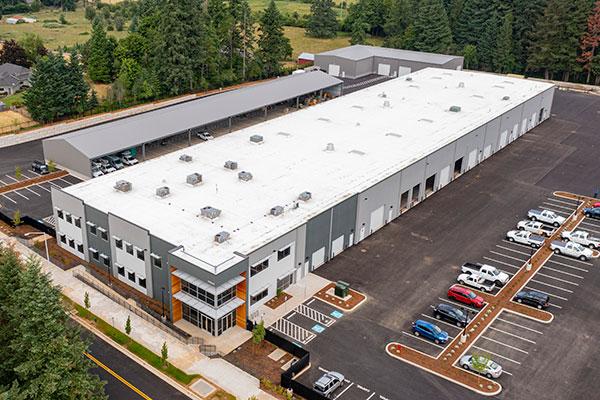When Transportation Maintenance receives a winter storm forecast, we divide our workforce into 2, 12-hour shifts to provide 24-hour coverage on the county road network. Our approach is to get ahead of weather events to provide the safest conditions possible for those traveling in Clackamas County.
Road maintenance priorities in winter weather
With more than 1,400 miles of county roads covering nearly 1,900 square miles, we have prioritized which roadways we attend to first, based on safety and meeting the needs of the largest number of people. As always, providing access for emergency vehicles is a top priority.
County roads are treated, plowed and sanded in the following order:
| High | Major transportation routes with moderate to high traffic volumes and major collector routes (roads that collect traffic from neighborhoods) with moderate traffic volumes and steep roads serving residential areas. Major route examples: Beavercreek Road and Sunnybrook Boulevard. |
| Medium | Minor collector routes, urban residential roads, and rural local roads that carry moderate to low traffic volumes. These are plowed during regularly-scheduled work hours when staff and equipment are available. |
| Low | Urban residential cul-de-sacs and rural local roads with low traffic volumes are plowed during regularly-scheduled work hours depending on staff and equipment availability. Due to the size of the county, it is rare that road crews make it to low priority streets. |
Once the severe weather is over, recovery may take even longer than the initial response. For example, sand applied during a 3-day snowstorm can take up to 3 weeks to remove. Therefore, we try to minimize the use of sand and use anti-icing material instead where possible.
Winter weather preparation and operations
Stockpiling
Storing necessary equipment and materials in anticipation of weather events allows us to be more effective and efficient. We have 18 sites throughout the county so trucks, equipment, and stockpiles of sand and magnesium chloride are ready when we need them.
Ice prevention
An application of chemicals that slows the formation of ice and prevents ice from sticking to the pavement. A solution of magnesium chloride can only be applied to the pavement when conditions are dry and the temperature is no higher than 40 degrees and falling. You may notice trucks spraying liquid in a series of lines that run along the road prior to freezing temperatures setting in, this is the ice prevention application.
Snow plowing
When snow accumulation has reached 2 inches and is continuing to fall, we will be on the roads plowing. We also plow bikeways that are directly connected to major roadways, but not bicycle lanes that are separated from the roadway by a barrier.
Snow/Ice removal
Snow plows clear the roadways and spread a mixture of sand and/or chemicals on top of the cleared snow pack or ice. When this layer softens after the treatment, then another pass of a snow plow will remove the next layer from the road surface to improve traction.
Clean-up
We sweep up sand from roads and on-street bicycle lanes after a winter storm to increase the safety of the roadway and protect environmental quality by keeping the sand and other de-icing materials out of the drainage system. Depending on the severity of the storm, clean-up can take several weeks.
How the public can help
If at all possible, don't abandon your vehicle on the roadway
Vehicles abandoned in the right-of-way create unsafe travel conditions for everyone else. Abandoned vehicles impact drivers' line of sight and block snowplows, emergency vehicles and public transit. If you abandon your vehicle in the right-of-way, you will be responsible for the towing expenses, as well as any damage caused from being an obstruction on the road.
Clear sidewalks, driveways and mailboxes
Property owners are responsible for removing snow from sidewalks in front of their property, and for clearing access to their driveway and mailbox. Please do not move snow onto the public roadway as you clear sidewalks and driveways, as this can create a hazard for travelers.
Increase your traction
You can equip your vehicle with better traction by using traction tires, snow chains or studded tires in winter weather. Practice putting snow chains or cables on your tires before the snow comes. Watch a video from ODOT showing how to install cable chains. If you use studded tires, note that they are allowed in Oregon from Nov. 1 to March 31.
Drive responsibly and be prepared
If staying home isn't an option during a winter weather event, you can plan ahead by giving yourself plenty of time to get to your destination, allowing for extra stopping distance and keeping tools in your car such as an ice scraper, car jack, jumper cables and road flares. Also bring water, food and blankets in your car if you have to venture out during a winter storm. You can use TripCheck to find road and weather conditions to be informed before you leave.
Contact us
If you have a concern about an unsafe roadway, please contact:
- Transportation Maintenance, 503-557-6391, during regular business hours (Monday through Thursday, 7 a.m. to 5:30 p.m.) or during ongoing snowplowing operations. You can also report road concerns online or by email at RoadConcerns@clackamas.us.
- Sheriff/C-COM non-emergency number, 503-655-8211, after hours and during weekends and holidays.
 Translate
Translate






